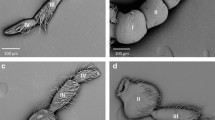Summary
In addition to setae, the first antennae of Conchoecia spinirostris also bear soft sensory tubes (♀∶4 tubes + 1 seta; ♂∶2 tubes + 3 setae). These tubes were examined electron microscopically. Each tube is divided into 4 regions: the stem, the bulbous region, the main region, and the tip. A tube contains 40–60 multiciliated dendrites, some hypodermal cells, and nonneuronal cells, and it has a specialized cuticle. Each dendrite develops within the tube, on the terminal 5–8 μm of its inner dendritic segment, approx. 25 cilia in a 9 × 2 + 0 pattern, whose rootlets are absent or only poorly developed. Each cilium splits up into 9 ramifications which extend into the tip. These ramifications partly take a spirallike course and form a ring in the distal main part beneath the cuticle. Their membranes often dilate into spindleshaped swellings. In the center of the middle and distal parts of the main region approx. 7 dendrites without cilia are located, one of them reaches into the tip. The poreless cuticle is extremely delicate and electron lucid. In contrast to the cuticle of the setae it is elastic and soft. Special substructures are described. The tubes are completely covered by a filamentous surface coat. Because of the structure and the thin walled nature of the cuticle, permeability for dissolved substances is assumed. The ciliary ramifications are likely to represent the receptive apparatus. The sensory tubes are interpreted as chemoreceptors. They can best be compared with the chemoreceptors of certain crustaceans, but differ strongly from the types of sensilla found in insects.
Similar content being viewed by others
References
Altner, H.: Insektensensillen: Bau- und Funktionsprinzipien. Verh. Dtsch. Zool. Ges. 1977, 139–153 (1977)
Altner, H., Ernst, K.D.: Struktureigentümlichkeiten antennaler Sensillen bodenlebender Collembolen. Pedobiologia 14, 118–122 (1974)
Altner, H., Sass, H., Altner, I.: Relationship between structure and function of antennal chemo-, hygro-, and thermoreceptive sensilla in Periplaneta americana. Cell. Tissue Res. 176, 389–405 (1977)
Altner, H., Tichy, H., Altner, I.: Lamellated outer dendritic segments of a sensory cell within a poreless thermo and hygroreceptive sensillum of the insect Carausius morosus. Cell Tissue Res. 191, 287–304 (1978)
Andersson, A.: The ultrastructure of a presumed chemoreceptor aesthetasc “Y” of a cypridid ostracod. Zool. Scripta 4, 151–158 (1975)
Andersson, A.: The organ of Bellonci in ostracodes: an ultrastructural study of the rod-shaped, or frontal organ. Acta Zool. (Stockholm) 58, 197–204 (1977)
Claus, C.: Die Halocypriden des atlantischen Ozeans und Mittelmeeres. Wien (1891)
Dahl, E.: Antennal sensory hairs in talitrid amphipods (Crustacea). Acta Zool. 54, 161–171 (1973)
Elofsson, R.: The ultrastructure of a chemoreceptor organ in the head of copepod crustaceans. Acta Zool. 52, 299–315 (1971)
Ernst, K.D.: Die Feinstruktur von Riechsensillen auf der Antenne des Aaskäfers Necrophours (Coleoptera). Z. Zellforsch. 94, 72–102 (1969)
Foelix, R.F., Chu-Wang, I.W., Beck, L.: Fine structure of tarsal sensory organs in the whip-spider Admetus pumilio (Amblypygii; Arachnida). Tissue Cell 7, 331–346 (1975)
Ghiradella, H., Cronshaw, J., Case, J.: Fine structure of the aesthetasc hairs of Pagurus hirsutiusculus Dana. Protoplasma 66, 1–20 (1968a)
Ghiradella, H., Case, J., Cronshaw, J.: Structure of aesthetascs in selected marine and terrestrial decapods: chemoreceptors and environment. Am. Zoologist 8, 603–621 (1968b)
Karuhize, G.R.: The structure of the postantennal organ in Onychiurus sp. (Insecta; Ccllembola) and its connection to the central nervous system. Z. Zellforsch. 118, 263–282 (1971)
Laverack, M.S., Ardill, D.J.: The innervation of the aesthetasc hairs of Panulirus argus. Quart. J. Micr. Sci. 106, 45–60 (1965)
Loftus, R.: Cold-receptor on the antenna of Periplaneta americana. Z. vergl. Physiol. 52, 380–385 (1966)
Loftus, R.: The response of the antennal cold receptor of Periplaneta americana to rapid temperature changes and to steady temperature. Z. vergl. Physiol. 59, 413–455 (1968)
Loftus, R.: Differential thermal components in the response of the antennal cold receptor of Periplaneta americana to slowly changing temperature. Z. vergl. Physiol. 63, 415–433 (1969)
Loftus, R.: Temperature-dependent dry receptor on antenna of Periplaneta. J. Comp. Physiol. 111, 153–170 (1976)
Müller, G.W.: Die Ostracoden des Golfes von Neapel und der angrenzenden Meeresabschnitte. In: Fauna und Flora des Golfes von Neapel, ed. by Zool. Station Neapel, 21. Monographie (1894)
Ong, J.E.: The fine structure of the mandibular sensory receptors in the brackish water calanoid copepod Gladioferens pectinatus (Brady). Z. Zellforsch. 97, 178–195 (1969)
Peters, A., Palay, S.L., Webster, H. de F.: The fine structure of the nervous system. 1st edition; New York, Evanston, and London: Harper and Row (1970)
Risler, H.: Die Sinnesorgane von Porcellio scaber Latr. (Crustacea, Isopoda). Zool. Jb. Anat. 98, 29–52 (1977)
Schaller, D.: Antennal sensory system of Periplaneta americana L. Distribution and frequency of morphologic types of sensilla and their sex-specific changing during postembryonic development. Cell Tissue Res. 191, 121–139 (1978)
Tichy, H.: Untersuchungen über die Feinstruktur des Tömösvaryschen Sinnesorgans von Lithobius forficatus L. (Chilopoda) und zur Frage seiner Funktion. Zool. Jb. Anat. 91, 93–139 (1973)
Yokohari, F., Tominaga, Y., Ando, M., Tateda, H.: An antennal hygrosensillum of the cockroach. J. Electron Microsc. (Tokyo) 24, 291–293 (1976)
Author information
Authors and Affiliations
Additional information
Supported by project 3540 of the “Fonds zur Förderung der wissenschaftlichen Forschung in Österreich”. The author is deeply indebted to Prof. Gamulin (Dubrovnik) for his support and to Prof. R. Riedl and Dr. W. Klepal for helpful discussions
Rights and permissions
About this article
Cite this article
Heimann, P. Fine structure of sensory tubes on the antennule of Conchoecia spinirostris (Ostracoda, Crustacea). Cell Tissue Res. 202, 461–477 (1979). https://doi.org/10.1007/BF00220438
Accepted:
Issue Date:
DOI: https://doi.org/10.1007/BF00220438




